The Story of John Casey from Glensaul, Co Mayo
1887 – 1918
by
Margaret Mary Joyce
March 21st 2018 dawned cold and blustery in Northern France. We arrived at the goal of our journey: the grave of Private John Casey, 7849 Connaught Rangers, from Glensaul, Co Mayo, killed at the Somme 21st of March 1918 and buried in the peaceful Ste Emile cemetery, one of the 280 war cemeteries in the north of France, after the four years of conflict and carnage that was World War I. We were the first members of John Casey’s family to stand at his grave on the 100th Anniversary of his death.
Four of us had made the journey from Dublin. My brother Dermot, nephew Ross and myself, along with a friend, had taken an early flight, hired a car at Beauvais Airport and driven north to Peronne and eastwards across the Somme valley to the little town of Villers Faucon. In the beautifully kept British War Cemetery at Sainte Emilie, just 2 miles further on, we found the grave of John Casey from Greenaune, Glensaul, my long lost grand-
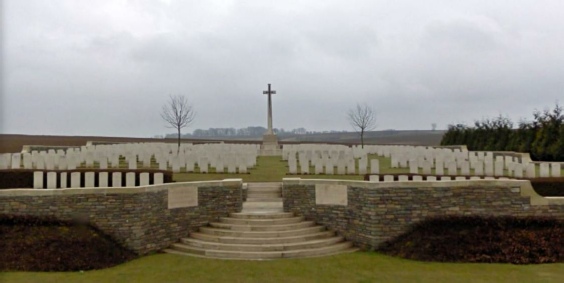
Who was John Casey? And how did he come to be at the Somme, on the Western Front, that fateful day in 1918? For me the story begins with my Grandmother Anna Josephine Casey, who lived with us when I was growing up. In the way of children I never thought to ask her many questions about her life but certain facts filtered through to me.
She was taken away from her home in Glensaul, on the back of a horse to live with her maternal grand-

I had thought that the whole family had been split up but the 1901 Census shows them still living in Greenaune with their grandmother, while my grandmother, Anna is listed as living with her Darmody grandparents across the valley in Garranageera. She was 9 at the time of the census. The other two members of her grandparents family were her mother’s younger sister and brother, Bridget 22 and John aged 30. How strange it must have been for her living with such an adult family.
The following 10 years brought huge changes to the two households. By the time of the 1911 Census neither exists any more. Anna’s Darmody grandmother, Bridget, died in 1904 when she was 13. Her Darmody grandfather, now blind, is listed in the census as living with another married daughter. Her uncle John and aunt Bridget had left to find work elsewhere. At some point after her grandmother’s death, Anna must have gone back to live with her Casey siblings but that household too, was to break up before 1911. The boys John and Martin presumably left to find employment when they reached adulthood, probably to Scotland. their Casey grandmother must also have died and the three remaining members of the family, Mary, Cathy and Anna, like so many before them, set out on the perilous journey of emigration to the USA. They travelled to Cleveland, the favoured destination of Mayo emigrants. I once heard my grandmother say that the journey was so horrendous she just wanted to die. There she married but returned to Ireland in 1930 with her husband and their 15 year old daughter – my mother.
My grandmother always wondered what became of her brother John. Her childhood memory was of him leaning against the door playing the tin whistle. She didn’t seem to have the same concern about her other brother Martin so maybe she knew of his whereabouts? Then, sometime in the mid ‘80s I remember my father reading the Westport Historical Journal ‘Cathar na Mart’ and remarking to my mother that Nanny’s brother was mentioned in it as having died at the Somme in 1918, a member of the Connaught Rangers. ‘So that’s what happened to him’ was my mother’s reply. At that time Nanny was already dead 10 years and the matter rested there.
Fast forward to August 2nd 2017. I was in Westport with Dermot, my brother. It was his birthday, and also that of my grandmother, Anna Casey, her 126th birthday at that! We went into Clew Bay Heritage Centre on the Quay and there in front of me were some old copies of ‘Cathar na Mart’. I enquired about back copies seeking the article about World War I that my father had read all those years ago. There in a 1987 edition I found the piece about the County Mayo men who had died serving with the Connaught Rangers and among the list of names, there was my grand-
March 21st 1918 was an infamous day of World War 1 – the day the Germans began a final push on the Allies leaving 38,000 casualties and 8,000 dead by the end of the day. This was the 2nd worst day of losses of that war.
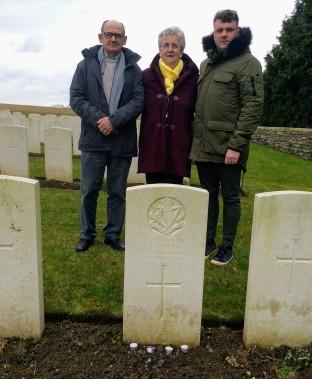
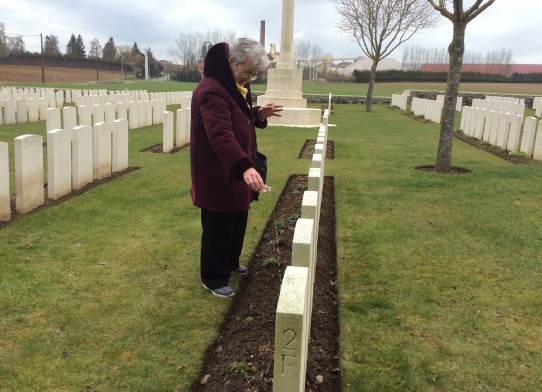
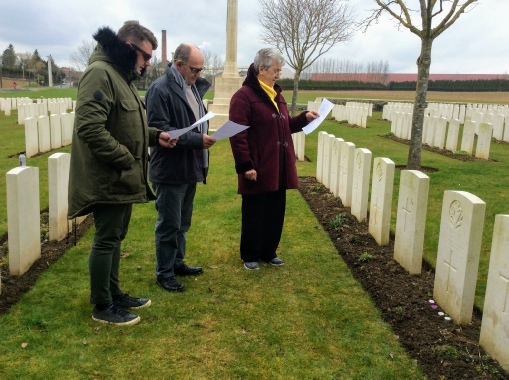
I poured water from the Glensaul river on his grave – a river he would have crossed every day on his way to school. We lit candles, set shamrock over him, prayed, read a little farewell salutation we had written, wandered away and wandered back again. It was such a sacred, overwhelming, wordless, privileged experience for us to be there and on that special date.
From the voluminous writings and analyses of that day we have even been able to deduce from the probable time and place of John’s death. By the time we reached the graveyard it was almost as if we had been there before. Thanks to Google maps we had seen live photos of it and the exact position of his plot. We were even able to see a photo of John’s actual grave before we even got there. Ross was amazed at how unerringly I went up the steps, through the gates and, walking through the serried rows, straight to John’s grave. It was such an emotional moment. ‘I have found you’ I heard myself saying as I took hold of his tombstone with my two hands. Dermot knelt and prayed and then hugged me. Ross poignantly noted that he was the same age as John when he died.
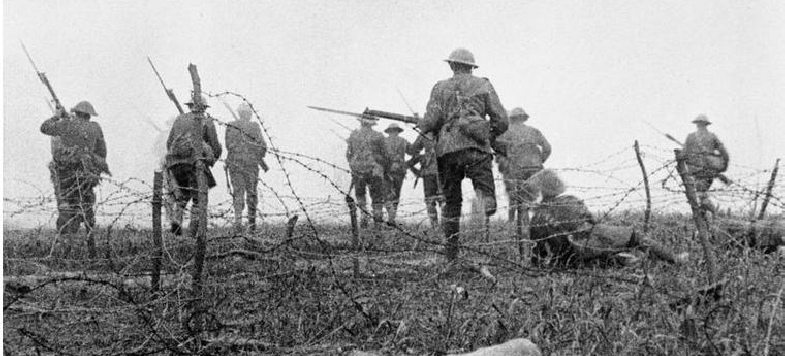
We met another family from Cork on the same mission that evening and they put us in touch with a poem called ‘The Day My Family Came’. It felt as if John had come to meet us – that he was so glad we had come. No one of his family had ever known where he was. No one of his family had been able to say ‘goodbye’ or say a prayer by his graveside before. The poem seemed to come from him and it heightened our experience.
And then there was the matter of the Map….!
There was one World War I map in particular which we had tried in vain to source. It was one which gave exact coordinates of where John’s body was initially found and therefore very close to where he fell. In an extraordinary way that said John was working with us, there just happened to be an Irish man from Artane sitting on the graveyard wall having a pint(!) when we arrived. It turned out he was a real WWI buff and had the map we looking for! As the morning wore on the sun came out and shone on the field opposite the graveyard. It seemed to pinpoint the spot where John had fallen and where his body had been found when the battlefield clearances began after the war ended. He was in a grave with six others and the only one there who could be identified because his tag number was intact on his body. Unlike the French who used mass graves to rebury their unidentified dead the British decided to give individual graves to each of their soldiers, even those who could not be identified. There are many “Unknown soldier” graves, bearing the inscription “Known unto God” in Ste. Emelie alongside John’s.
There were so many coincidences – not really coincidences -
I look forward to meeting him some day.
I líontaibh Dé go gcastar sinn….
Shot had come from left and right
With shrapnel, shell and flame
And turned my sunlit days to night
Where now none would call my name.
Years passed me by as I waited,
Missed the generations yet to come,
Sadly knew I would not be fated
To be a father, hold a son.
More years passed, new voices came,
The stones and trenches to explore,
But no-
So I wished and waited ever more.
Each time I thought, perhaps, perhaps,
Perhaps this time they must call me,
But they only called for other chaps,
No-
Through years of lonely vigil kept,
To look for me they never came,
None ever searched or even wept,
Nobody stayed to speak my name.
Until that summer day I heard
Some voices soft and strained with tears,
Then I knew that they had come
To roll away those wasted years.
Their hearts felt out to hold me,
Made me whole like other men,
But they had come just me to see,
Drawing me back home with them.
Now I am at peace and free to roam
Where 'ere my family speak my name,
That day my soul was called back home
For on that day my family came.
The Day My Family Came’
by Michael Edwards.